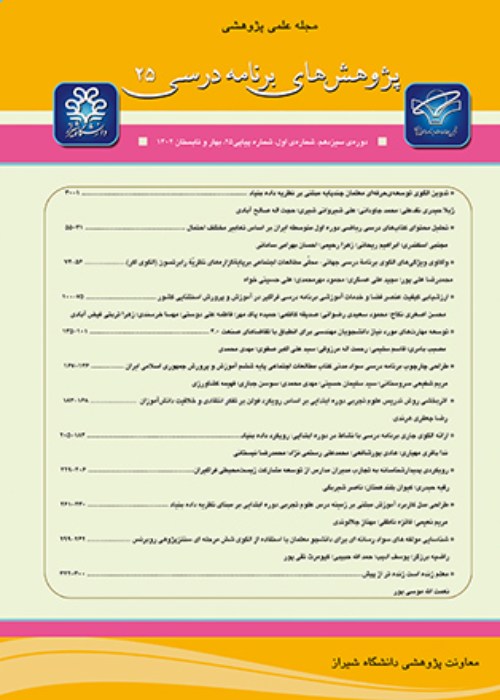An Explanation of the Synergistic Approach in Miller’s Theory of Curriculum Using Systems Theory
In this research, the theoretical foundations reflected in the Miller’s (2019) theory of curriculum were used to analyze the synergistic approach in his curriculum elements. In accomplishing this goal, systems theory was employed to explain the nature of the components of his proposed curriculum in the education system. A review of the literature shows that no study has been done yet to explain the synergistic approach in Miller’s (2019) curriculum elements. Considering the theoretical and practical importance of synergy, which has been highlighted in various studies, and that the formulation and implementation of an efficient curriculum is one of the main concerns in any education system, the main goal of the current research was to explain the synergistic approach in Miller’s curriculum elements using the systems theory.
Research questions:
The study questions were as follows: 1. How do the research findings explain the objectives of a synergistic curriculum ? 2. What are the characteristics of students included in a synergistic curriculum ? 3. What are the roles and duties of teachers in a synergistic curriculum ? 4. What are the teaching-learning approaches in a synergistic curriculum ? 5. What are the characteristics of the educational environment in a synergistic curriculum ? 6. What are the evaluation approaches in a synergistic curriculum?
The current research was conducted to explain the synergistic approach reflected in Miller’s (2019) curriculum elements using a systematic review method. Purposive sampling was used to collect the data, and comparative content analysis was used to analyze the collected data. In this study, the relevant research on the topic of synergy in curriculum studies was identified and carefully examined. In the next phase of the study, an attempt was made to explicate the nature of a synergistic approach reflected in the six elements of Miller’s curriculum. In so doing, the seven steps suggested by Sandelowski and Barros (2007) were used to analyze the data.
The findings showed that the nature of synergistic curriculum planning, that is, participation in the production, implementation, and evaluation of a curriculum, involves the participation of a larger group of educational stakeholders. According to the findings, promoting cooperation among individuals, tapping into each individual’s skills, and using expert opinions lead to a more satisfactory and elaborate outcome, which crystallizes the true meaning of collaboration. Students are considered as a dynamic and active element in a synergistic program in all fields. Hathib (2016) emphasized that students in a synergistic curriculum had “the spirit of teamwork, mutual understanding, free-spirited attitude, mutual respect, and better understanding”. He also asserted that a synergistic curriculum could foster “group discussion, group assignments, and cooperative learning”. In a synergistic curriculum, the role of a teacher is that of a guide and a facilitator who combines teaching with technology and makes the class an attractive place for students. Moreover, such a teacher accompanies students in their quest for learning during the academic year as a driving force and source of enthusiasm. In a synergistic curriculum, special emphasis is placed on creating dialogue-oriented and collaborative environments, in which interactive learning, technological methods, and flipped learning take center stage. The learning environment in a synergistic curriculum is fertile for the expansion of cooperation and mutual respect. Participation and cooperation, as pointed out above, are of great importance. A synergistic curriculum is intended to create an environment that benefits from the use of educational technology to facilitate the process of knowledge acquisition. In such an environment, communication technologies are used to ease dialogue between learners and enhance their learning. Due to the nature of a synergistic curriculum, it is expected that no single specific method be considered for the evaluation of students; rather, teachers are encouraged to avail themselves of various complementary evaluation methods implemented formatively and qualitatively. In addition, the evaluation in a synergistic curriculum follows an integrated approach and takes into account all students’ activities.
In a synergistic curriculum, the emphasis put on the complementary role of the school and how to live peacefully is not limited to the roles of teachers, students, and the environment, yet it also highlights the importance of interacting and cooperating with all other stakeholders involved in the education system. Curriculum planning specialists strive to design programs that are based on systemic and synergistic theory. An indispensable element of such curriculums is paying attention to the integration of technology with teaching through the employment of teachers who are aware of the latest technological developments relevant to teaching and learning. A cooperative atmosphere in the classroom contributes to the dynamics of group work and boosts learners’ social activity, which, in turn, provides the ground for both teachers and learners to realize the spirit of synergy.
- حق عضویت دریافتی صرف حمایت از نشریات عضو و نگهداری، تکمیل و توسعه مگیران میشود.
- پرداخت حق اشتراک و دانلود مقالات اجازه بازنشر آن در سایر رسانههای چاپی و دیجیتال را به کاربر نمیدهد.





